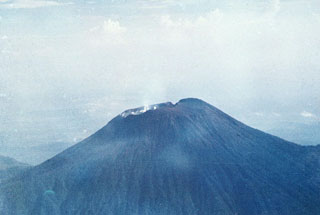Report on Slamet (Indonesia) — 7 October-13 October 2020
Smithsonian Institution / US Geological Survey
Weekly Volcanic Activity Report, 7 October-13 October 2020
Managing Editor: Sally Sennert.
Please cite this report as:
Global Volcanism Program, 2020. Report on Slamet (Indonesia) (Sennert, S, ed.). Weekly Volcanic Activity Report, 7 October-13 October 2020. Smithsonian Institution and US Geological Survey.
Slamet
Indonesia
7.242°S, 109.208°E; summit elev. 3428 m
All times are local (unless otherwise noted)
PVMBG reported that during 1 September-9 October white emissions rose as high as 100 m above Slamet’s summit. During the previous two weeks seismicity significantly decreased, specifically tremor and the signals indicating emissions. The magnitude of earthquakes returned to baseline levels. Tiltmeter data from an instrument on the upper E flank indicated inflation in the upper part of the edifice, though data from an instrument located N of the volcano indicated no overall deformation. On 8 October the Alert Level was lowered to 1 (on a scale of 1-4) and the public was warned to stay outside a radius of 1 km.
Geological Summary. Slamet is one of Java's most active volcanoes. It has a cluster of about three dozen cinder cones on its lower SE-NE flanks and a single cinder cone on the W flank. It is composed of two overlapping edifices, an older basaltic-andesite to andesitic volcano on the west and a younger basaltic to basaltic-andesite one on the east. Gunung Malang II cinder cone on the upper E flank on the younger edifice fed a lava flow that extends 6 km E. Four craters occur at the summit of Gunung Slamet, with activity migrating to the SW over time. Eruptions recorded since the 18th century have originated from a 150-m-deep, 450-m-wide, steep-walled crater at the western part of the summit and have consisted of explosive eruptions generally lasting a few days to a few weeks.
Source: Pusat Vulkanologi dan Mitigasi Bencana Geologi (PVMBG, also known as CVGHM)

